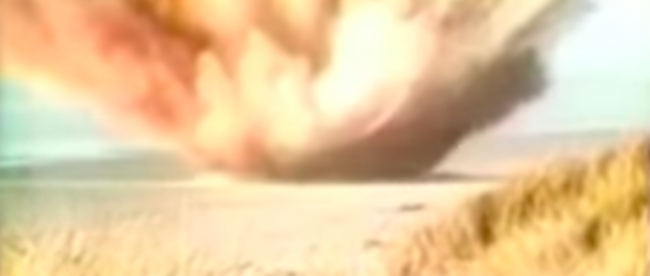The Day It Accidentally Rained Flying Whale Blubber

At about four meters (13 feet) long and weighing approximately half a short ton (~450 kg), newborn sperm whales are, by any definition, huge. And as the animals get older, they get even bigger — even the smaller ones are often five to ten times as large. And in 1970, that posed a giant problem for the small city of Florence, Oregon.
Florence is located on the Pacific coast, right where the Siuslaw River flows into the ocean. (Here’s a map.) And on November 9, 1970, it received an unwelcome visitor: a 45-foot, 8-short ton carcass of a dead whale washed ashore on one of the city’s beaches. News of the peculiarity spread quickly as the creature became the talk of the town; even a local car dealer got in on the action, promoting its sales by calling them “a whale of a deal on a new Oldsmobile.” Almost immediately, the whale became a morbid tourist attraction. Officials, fearful that people would climb on the carcass and get injured or worse, needed to clear the whale from the beach.
That’s easier said than done, though. It would take a huge crew to bury the beast, and even then, there were fears that explorers would later dig it up. You couldn’t haul it off, at least not in one piece. And unfortunately, we don’t have teleporters or magic at our disposal. It looked hopeless, but then someone came up with a simple, brilliant, and potentially idiotic idea: blow it up. With dynamite.
Within a day or two, the plan went forward. As NPR later recounted, “after consulting experts in the Navy and elsewhere, [Oregon highway engineer George] Thornton decided the best course of action would be to detonate the whale with enough force to disintegrate it into chunks that could be eaten by scavengers — ‘seagulls and crabs, and whatnot.'” Unfortunately, figuring out how much dynamite was the right amount wasn’t so easy, and officials overestimated by a lot — perhaps using forty times (!) more dynamite than they needed.
Instead of disintegrating the whale, they made it rain whale blubber.
The plume of whale parts and beach soared 100 feet into the sky. According to the Oregon Encyclopedia, “chunks of the animal flew in every direction, and spectators began to scream and run for cover when they glimpsed large pieces soaring directly overhead.” (A grainy video of the explosion, as covered by the local news at the time, can be seen here, but you won’t hear much screaming because the news crew also had to make a run for it.) Blubber blobs flew as far as a quarter of a mile from the blast site, and virtually everyone who came to watch the historic blast was covered in whale bits.
Thankfully, no one got significantly hurt, but there was one casualty of sorts. According to Offbeat Oregon, a businessman named Walt Umenhofer lost his car when a huge chunk of whale crashed through the passenger canopy. Umenhofer didn’t have the car for very long — he had just bought it days earlier during the “whale of a deal on a new Oldsmobile” promotion.
Bonus fact: What happens now if a dead whale ends up on the shore? After the events described above, Oregon doesn’t blow them up anymore. Another whale washed up on the shore of Florence’s beaches in 2009, but this time, dynamite never entered the equation. According to the local Fox affiliate, the state’s policy is to bury the carcass: crews “bury the whale carcass within the park boundary” and “if the sand isn’t deep enough [it is] taken to another beach to be buried.”
From the Archives: A Whale of a Discovery: Finding a sperm whale’s puke can make you rich.
